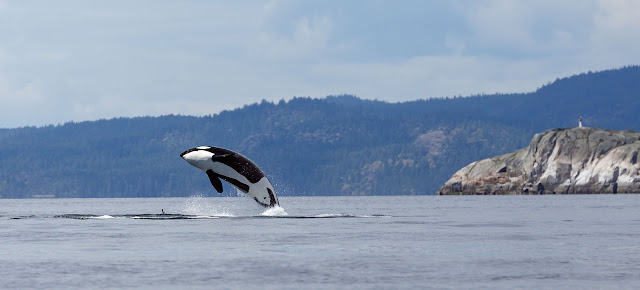 |
| Photo courtesy of Simon Pidcock |
Orca
whales are cetaceans, a large group of approximately 80 kinds of
whales, dolphins, and porpoises. The largest member of the dolphin
family (females can grow as large as 23 feet in length, while males can
reach 32 feet), orca whales have highly developed brains, and like all
dolphins, use sophisticated biological sonar called echolocation, to
communicate with one another. When the Southern Resident Community
whales arrive in Haro Strait on the southeast shores of Vancouver
Island, they “announce” their arrival to other whales already in the
area with their highly developed vocal activity.
Types of Orcas
Orca
whales are divided into three separate categories based upon
geographical location and behavior. It is speculated that these three
distinct groups of orcas in the Pacific Northwest may be the result of
food preference and availability.
Resident
Orcas tend to have distinct and stable migration patterns and family
structures, while Transient Orca Whales are more loosely organized. It
is estimated that there are approximately 450 Transient Orca Whales
living along the western North American seaboard from Mexico to the
Bering Sea. Little is currently known about the third category, Offshore
Orcas, although they are being actively studied by scientists.
Discovered in 1991, the Offshore Orcas are most commonly seen 15 to 25
miles out at sea off Vancouver Island and the Queen Charlotte Islands.
It is possible that this third category of whales is the ancestral
population of the Northern and or the Southern Resident orca whales.
Social Structure
Orca
whales generally live in groups known as pods, which are comprised of
two or more females, calves, one or more males, and juveniles. These
stable, matrilineal pods of orcas often consist of a mother, her
offspring, and several generations of family members who travel
together. Some offspring stay with their mother for life. This type of
familial structured pod has been consistently observed in the Pacific
Northwest. While all pods share common sounds, each pod also has its own
distinctive sound.
 |
| Photo courtesy of Simon Pidcock |
With
46 to 50 conical shaped teeth that point slightly inwards and
backwards, the orca is well adapted for hunting. While resident orca
whales tend to feed on fish species such as herring or salmon, transient
whales eat a variety of animals including smaller whales, penguins,
porpoises, harbour seals, sea lions, squid and sharks. Orcas generally
forage individually, although it is thought by scientists that a
coordinated method of group hunting probably occurs.
Although
very little is understood about the orca's breeding habits, newborn
calves have been observed throughout the year, indicating no particular
breeding season. Orcas are considered to be sexually mature between the
ages of 10 and 18 years of age, with females believed to be
reproductively active into their 40's. The gestation period for an orca
is approximately between 13 to 17 months, and a newborn calf is
generally about 6-7 feet long, and weighs approximately 400 pounds.
When
resting, orca whales generally maintain a slow swimming speed (2 knots
or less), and synchronize their breathing with other whales within their
social group. They also rest while laying almost motionless on the
surface of the water. During these very quiet rest periods, orcas emit
just a few discrete sounds, and scientists believe that one group member
may remain more attentive than the remaining pod.
In 2016 we will be running a few workshops to photograph the orcas, our next one can be seen here, http://northof49photography.com/vancouver-island-workshop
No comments:
Post a Comment